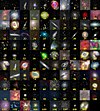NGC 6729
| Reflexionsnebel | |
|---|---|
| NGC 6729 | |
 | |
| Im Bildzentrum: R Coronae Australis (Falschfarbenaufnahme des VLT) | |
| Sternbild | Südliche Krone |
| Position Äquinoktium: J2000.0 | |
| Rektaszension | 19h 01m 55,4s [1] |
| Deklination | -36° 57′ 28″ [1] |
| Weitere Daten | |
| Winkelausdehnung | 2,5' × 2,0' [2] |
| Zugehörigkeit | |
| Entfernung | 400 Lichtjahre |
| Geschichte | |
| Entdeckung | Julius Schmidt |
| Datum der Entdeckung | 15. Juni 1861 |
| Katalogbezeichnungen | |
| NGC 6729 • ESO 396-N15 | |
| Aladin previewer | |
NGC 6729 ist ein veränderlicher Nebel (eine Art von Reflexionsnebel) im Sternbild Corona Australis. Der Nebel reflektiert das vom PMS-Stern R Coronae Australis (R CrA) ausgesandte Licht. NGC 6729 hat eine dreieckförmige Gestalt, die an NGC 2261 erinnert.
Der Nebel wurde von Johann Friedrich Julius Schmidt im Jahr 1861 entdeckt.[3]
Weblinks
- ESO: Dramatische Sterngeburt +Foto,Karte&Animation – 16. März 2011
- Spektrum.de: Amateuraufnahmen [1]
Einzelnachweise
Auf dieser Seite verwendete Medien
Autor/Urheber: ESO/Sergey Stepanenko, Lizenz: CC BY 4.0
This very detailed false-colour image from ESO’s Very Large Telescope shows the dramatic effects of very young stars on the dust and gas from which they were born in the star-forming region NGC 6729. The baby stars are invisible in this picture, being hidden behind dust clouds at the upper left of the picture, but material they are ejecting is crashing into the surroundings at speeds of that can be as high as one million kilometres per hour. This picture was taken by the FORS1 instrument and records the scene in the light of glowing hydrogen and sulphur.
Autor/Urheber: Roberto Mura, Lizenz: CC BY-SA 3.0
Caldwell Catalogue objects.


